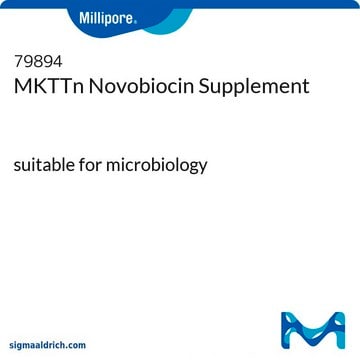1.09878
Modified Semi-solid RAPPAPORT-VASSILIADIS medium (base)
pkg of 500 g, ISO 6579, for Salmonella spp.
Synonim(y):
MSRV medium (base)
About This Item
Polecane produkty
agency
ISO 6579
Poziom jakości
Postać
powder (dehydrated (DCM))
opakowanie
pkg of 500 g
producent / nazwa handlowa
GranuCult®
metody
microbiological culture: suitable
pH
5.1-5.4 (25 °C, 31.8 g/L in H2O)
rozpuszczalność
31.6 g/L
Zastosowanie
food and beverages
microbiology
temp. przechowywania
15-25°C
przydatność
Salmonella spp.
Opis ogólny
Zastosowanie
Komentarz do analizy
Appearance (color): blue
pH-value (25 °C): 5.1 - 5.4
Growth promotion test in accordance with the current version of DIN EN ISO 11133.
Growth (Salmonella typhimurium ATCC 14028 (WDCM 00031)): Grey-white, turbid zone extending out from inoculated drop. After 24–48 h, the turbid zone will be (almost) fully migrated over the plate.
Growth (Salmonella enteritidis ATCC 13076 (WDCM 00030)): Grey-white, turbid zone extending out from inoculated drop. After 24–48 h, the turbid zone will be (almost) fully migrated over the plate.
Growth (Escherichia coli ATCC 8739 (WDCM 00012)): Possible growth at the place of the inoculated drop without a turbid zone.
Growth (Escherichia coli ATCC 25922 (WDCM 00013)): Possible growth at the place of the inoculated drop without a turbid zone.
Growth (Citrobacter freundii ATCC 8090): no growth or possible growth at the place of the inoculated drop without a turbid zone.
Growth (Enterococcus faecalis ATCC 19433 (WDCM 00009)): no growth
Growth (Enterococcus faecalis ATCC 29212 (WDCM 00087)): no growth
Incubation:
2 x 24 ± 3 hours at 41,5 ± 1 °C aerobic.
Przypis
The designations basic, plus, or prime are added to indicate the quality control level, from basic quality control to standard QC plus to prime for full regulatory compliance.
Informacje prawne
Kod klasy składowania
11 - Combustible Solids
Klasa zagrożenia wodnego (WGK)
WGK 1
Certyfikaty analizy (CoA)
Poszukaj Certyfikaty analizy (CoA), wpisując numer partii/serii produktów. Numery serii i partii można znaleźć na etykiecie produktu po słowach „seria” lub „partia”.
Masz już ten produkt?
Dokumenty związane z niedawno zakupionymi produktami zostały zamieszczone w Bibliotece dokumentów.
Protokoły
Norma EN ISO 6579-1 określa wykrywanie Salmonella spp. w próbkach przeznaczonych do spożycia przez ludzi, paszach dla zwierząt i próbkach środowiskowych.
EN ISO 6579-1 standard specifies detection of Salmonella spp. in human consumption, animal feed, and environmental samples.
Nasz zespół naukowców ma doświadczenie we wszystkich obszarach badań, w tym w naukach przyrodniczych, materiałoznawstwie, syntezie chemicznej, chromatografii, analityce i wielu innych dziedzinach.
Skontaktuj się z zespołem ds. pomocy technicznej






